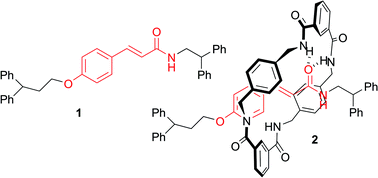Coumaric amiderotaxanes: effects of hydrogen bonding and mechanical interlocking on the photochemistry and photophysics†‡
Abstract

- This article is part of the themed collection: In honour of Vincenzo Balzani
* Corresponding authors
a
Van't Hoff Institute for Molecular Sciences, University of Amsterdam, Nieuwe Achtergracht 129, WS Amsterdam, The Netherlands
E-mail:
a.m.brouwer@uva.nl
Fax: +31 205255680
Tel: +31 205255491
b
School of Chemistry, University of Edinburgh, The King's Buildings, West Mains Road, Edinburgh, United Kingdom
E-mail:
David.Leigh@ed.ac.uk
Fax: +44 131 667 9085
Tel: +44 131 650 4730

 Please wait while we load your content...
Something went wrong. Try again?
Please wait while we load your content...
Something went wrong. Try again?
A. M. Brouwer, S. M. Fazio, N. Haraszkiewicz, D. A. Leigh and C. M. Lennon (neé Keaveney), Photochem. Photobiol. Sci., 2007, 6, 480 DOI: 10.1039/B618795A
To request permission to reproduce material from this article, please go to the Copyright Clearance Center request page.
If you are an author contributing to an RSC publication, you do not need to request permission provided correct acknowledgement is given.
If you are the author of this article, you do not need to request permission to reproduce figures and diagrams provided correct acknowledgement is given. If you want to reproduce the whole article in a third-party publication (excluding your thesis/dissertation for which permission is not required) please go to the Copyright Clearance Center request page.
Read more about how to correctly acknowledge RSC content.
 Fetching data from CrossRef.
Fetching data from CrossRef.
This may take some time to load.
Loading related content
